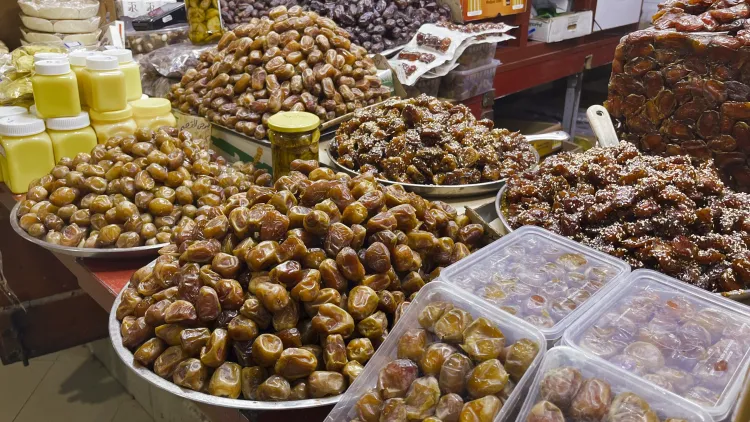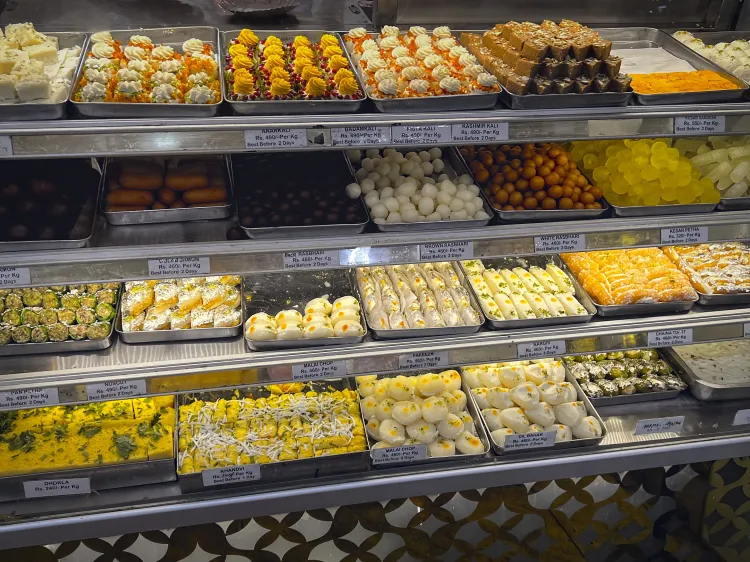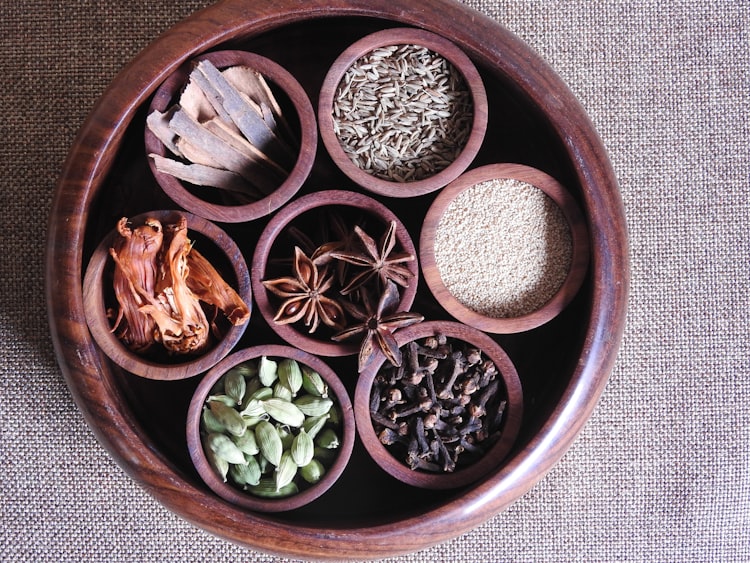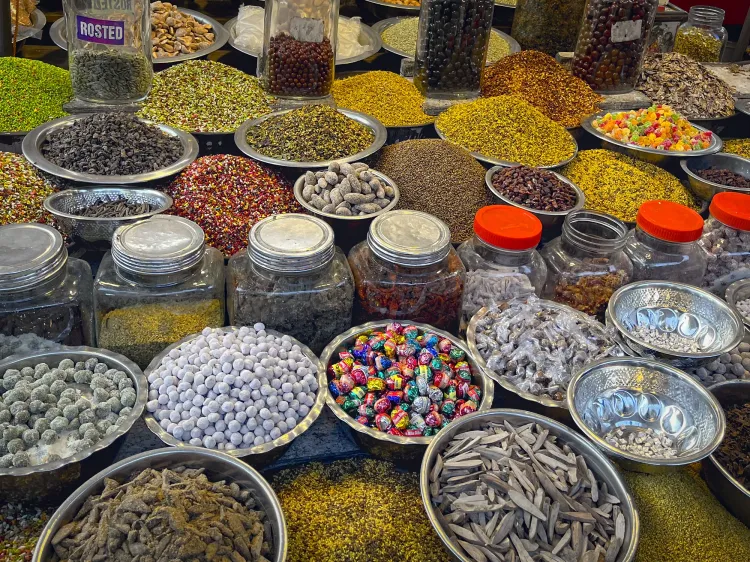Indian Gastronomy (Pt. 3 - Southern India)
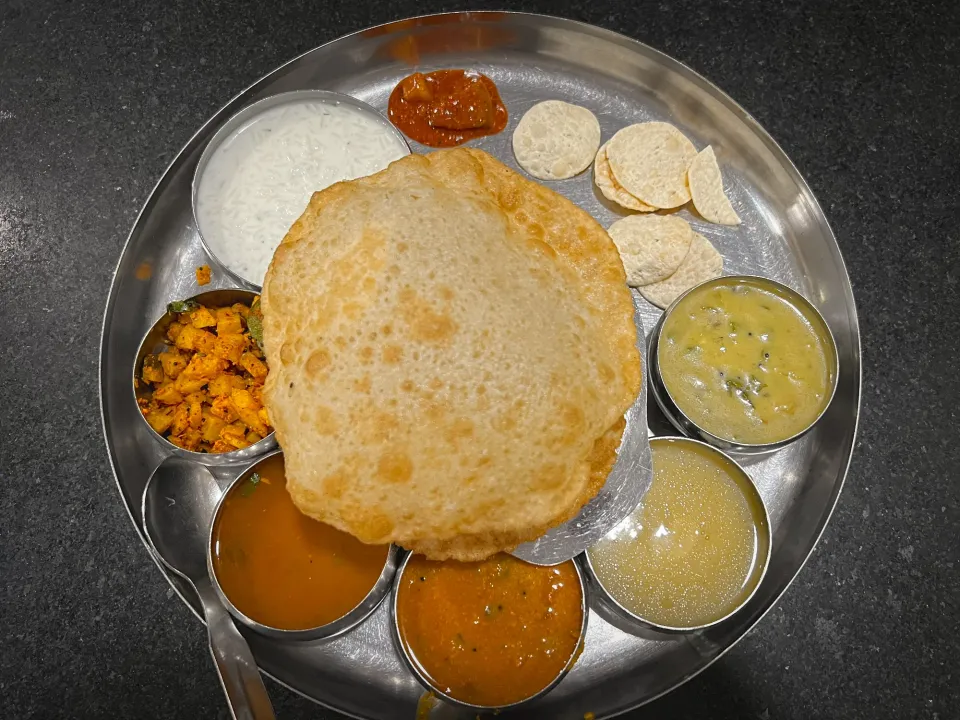
Indian gastronomy is one of the most influential cuisines on the planet. Thanks to the geographical variety and heavy uses of spices, the breadth and complexity of flavor of Indian food is absolutely incredible. From curries and breads, to lentils and stews, to heat galore, it is no wonder why Indian food is one of the most popular and beloved cuisines of all time.
India is one of the largest and most diverse countries in the world. Due to its sheer size, extreme regional variation, and depth of gastronomy, reviewing all of India in a single article would be completely overwhelming. India is most colloquially grouped together as North India and South India. Officially, it is divided into 6 zones: Northern, Central, Eastern, North Eastern, Western, and Southern. For the purposes of these gastronomy reviews, we will talk about India in 4 parts: Northern/Central, Western, Southern, and Eastern/North Eastern.
In Pt. 3, we will review South Indian cuisine. South Indian cuisine is known for its rice dishes, seafood, and intense use of spices. While South Indian cuisine is often overlooked internationally, it has a wealth of unique and delicious dishes to enjoy.

Culture and Geography
History
India is one of the powerful ancient civilizations, having been around since the transition to agriculture thousands of years ago. India began with varying rules and dynasties primarily within the sub-continent: starting with the Vedas from Central Asia / Punjab, the Maurya Empire from Northern India, followed by the famous Gupta Empire, ending with the Tripartite struggle in the north and a series of empires (most notably the Chola) in the south. I say "ending" here not by any means because Indian empires and dynasties stopped in the 13th century with the decline of the Chola, but because this is when the subcontinent's primarily self-contained struggles are introduced to overwhelming external influences.
India had been trading and having a profound impact on the Middle East for most of the classic and medieval periods. The Middle East reciprocated this impact on India in a much more drastic way starting in the early modern era. Islamic conquests of Northern India began around the 13th century. These were held off by a resurgence of powerful Hindu states like Mewar in Rajasthan, but by 1556 the Mughal Empire had officially established rule in India. It was during this time that India received a large dose of Middle Eastern / Persian influence. Most of North Indian cuisine is based on the intermingling of these two major cultures during this period. New sets of ingredients, a shift towards rice as a staple of the Indian gastronomic identity, and the introduction to a wide variety of milk-based sweets completely morphed Indian gastronomy into what it is today.
India eventually ousted the Mughal Empire from its long rule, only the be replaced by the British shortly after. At the beginning of the colonial period, it was the Portuguese who had first established trading posts in India, most notably Bombay / Mumbai, and a territory in Goa. Additionally, the Dutch and the French also began to develop territories in India, but these territories were limited in scope and influence. While the Portuguese have significantly influenced the cuisine and culture of Western India, the East India Company, aka the Great British Empire, was the predominant colonial force in India. The British came to rule almost the entirety of India/Pakistan for hundreds of years (over a hundred years of partial rule, with a period of direct rule under the British Raj from 1858 to 1947). They brought tons of new ingredients from the Americas to finish enriching Indian gastronomy to its modern form. Finally, India gained its independence in 1947, splitting with Pakistan, and has remained that way since.
Regions
The regions that define Southern India are Andhra Pradesh, Karnataka, Kerala, Puducherry, Tamil Nadu, and Telangana.
Regions
Andhra Pradesh
Karnataka
Kerala
Puducherry
Tamil Nadu
Telangana
Ingredients
India has one of the world's largest ingredient list, as a key feature of the cuisine is spices. As can be seen below, there are so many spices in the Indian kitchen, and they are used in everything. An important note would be masala. Masala, translated as "spices", refers to a specific mix of spices that is used frequently in many dishes.
Most famously for South Indian food, sambar powder is a mix of black peppercorns, coriander seeds, fenugreek seeds, mustard seeds, redchiliess, dal (usually chana or toor), and optionally cinnamon, coconut, cumin seeds, etc. Additionally, South Indian cuisine has a few preferred spices such as tamarind and curry leaves.
Major Spices
Garam Masala
Chaat Masala
Sambar Powder
Ajwain
Amchoor (dried mango powder)
Asafetida
Cardamom
Coriander
Cumin
Curry Leaves
Dried Chiles
Indian Bay Leaves
Fennel Seeds
Fenugreek
Mustard Seeds
Tamarind
Turmeric
Star Anise
Beans and legumes are popular throughout India. Lentils, black lentils, chickpeas, split yellow pigeon peas, and mung beans are popular protein sources in many dishes throughout India. While breads are made throughout India, Southern India is much more known for its use of rice. Seafood and fruits are also much more common in South India as it has a much more tropical climate with tons of coastline. Coconut oil and coconut milk are featured prominently in South Indian food instead of the creams and oils used in North India. In a similar vein, while South Indians do have curries they tend to be thinner, more like stews and soups, due to this change in ingredient(s). South Indian food also tends to be the hottest/spiciest of all the Indian regions.
Major Ingredients
Lentils
Chickpeas
Mung Beans / Green Gram (called Mung Dal)
Black lentils / Gram (called Urad beans)
Split yellow pigeon peas (called Toor dal)
Ghee (clarified butter)
Achaar (Indian pickles)
Yogurt
Paneer
Basmati Rice
Coconut Milk
Coconut Oil
International Highlights
Dosa
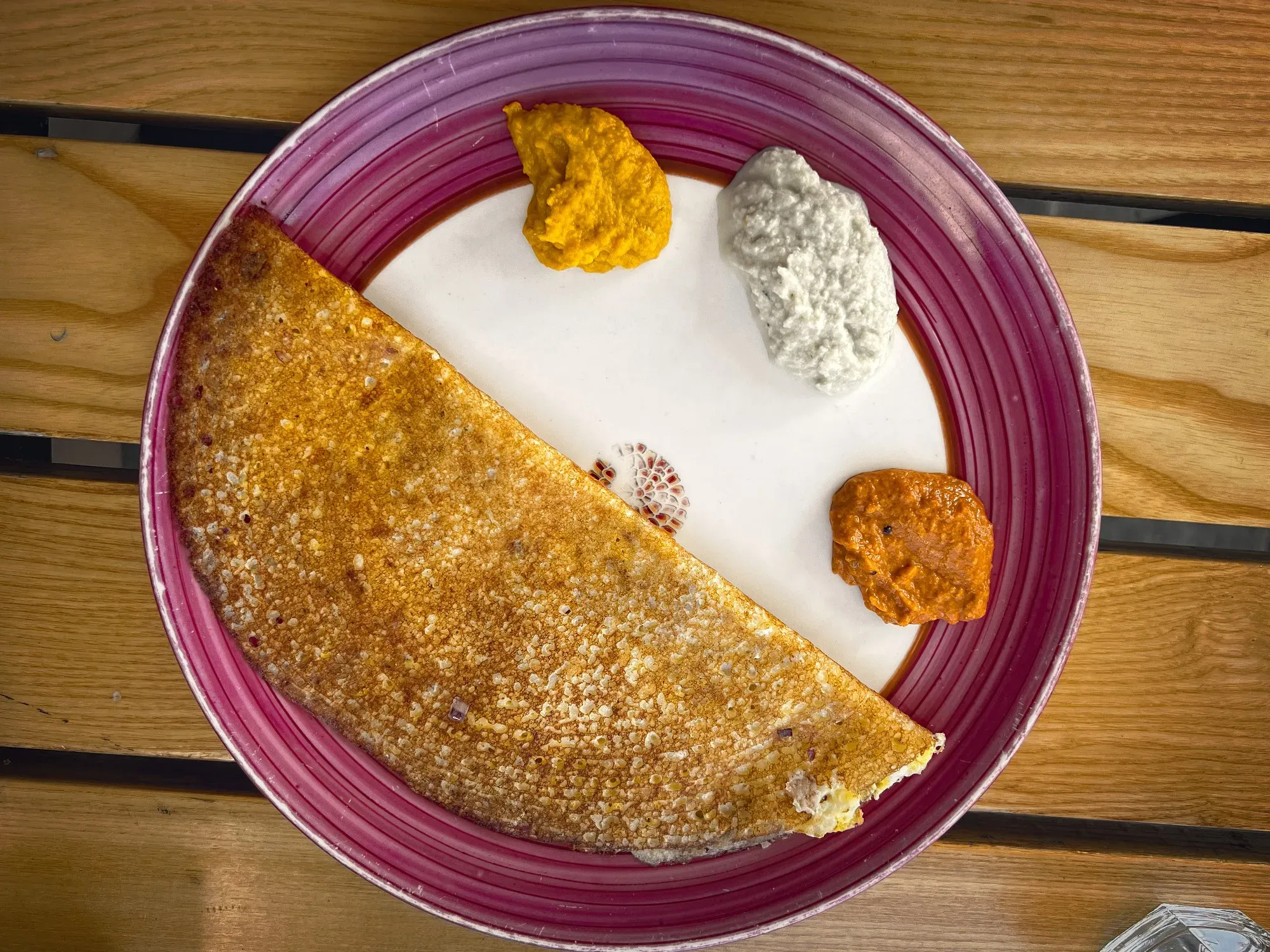
Dosa is a popular South Indian dish made from fermented rice and urad dal batter, cooked on a flat griddle. It is thin and crispy with a slightly tangy and savory taste. It is usually served with sambar, coconut chutney, peanut chutney, and/or tomato & onion chutney.
The origin of dosa can be traced back to the Southern Indian state of Tamil Nadu, where it was a popular breakfast item. It has since spread throughout the country and is now enjoyed as a popular street food and restaurant dish in many parts of India and abroad. Dosa is a versatile and delicious dish that has become the poster-child of South Indian cuisine.
There are many varieties of dosa, including masala dosa, which is filled with a spicy potato filling; Mysore masala dosa, which is made with a special spice mix; and, paper dosa, which is named after its paper-thin and crispy nature, similar to a crepe. Other popular dosa varieties include the adai dosa, onion dosa, rava dosa, neer dosa, pesarattu, set dosa, spring dosa, and pav bhaji dosa.
Idli
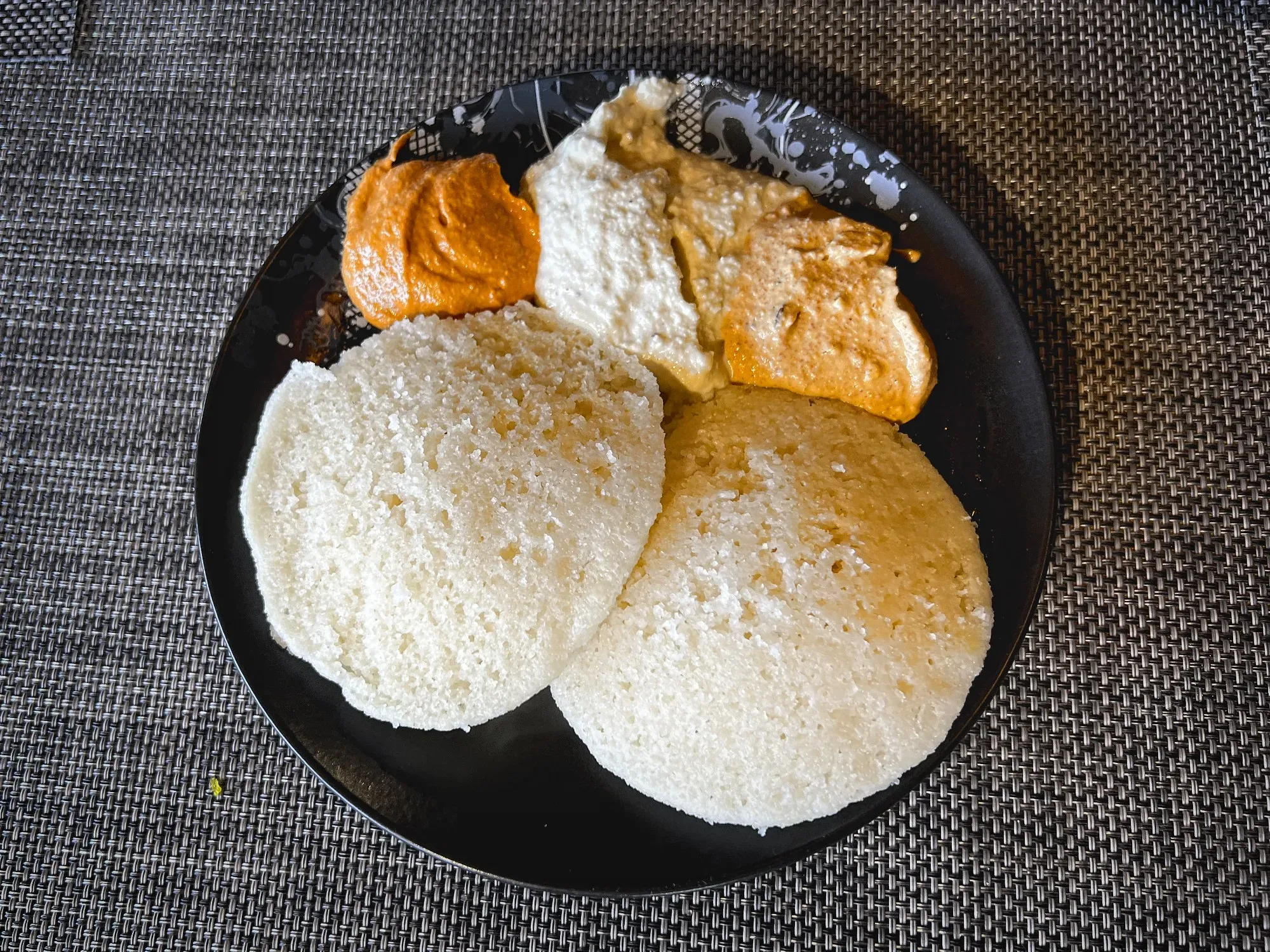
Idli is a steamed rice and urad dal cake that is a staple breakfast dish in Southern India. It is made by soaking and grinding a mixture of rice and urad dal, and then allowing it to ferment overnight. The fermented batter is then poured into molds and steamed until fluffy and spongy. Idlis are usually served with coconut chutney, sambar, and a variety of other accompaniments.
The exact origin of idli is unclear, but it is believed to have originated in present-day Tamil Nadu in South India. The earliest written reference to idli is found in the 920 AD Kannada language work Vaddaradhane, which describes the preparation of idli. Idlis were traditionally made using a stone grinder called a "ural" and a flat grinding stone called an "ulakkai."
Idlis are a nutritious and healthy breakfast option as they are low in fat and high in protein. They are also easy to digest due to the fermentation process, which increases the bioavailability of nutrients. Over time, several variations of idli have emerged, including rava idli (made with semolina), masala idli (spiced with vegetables), oats idli (made with oats and urad dal), and many many more. Today, idlis are a popular breakfast food not only in South India but also throughout the country and around the world.
Vadas
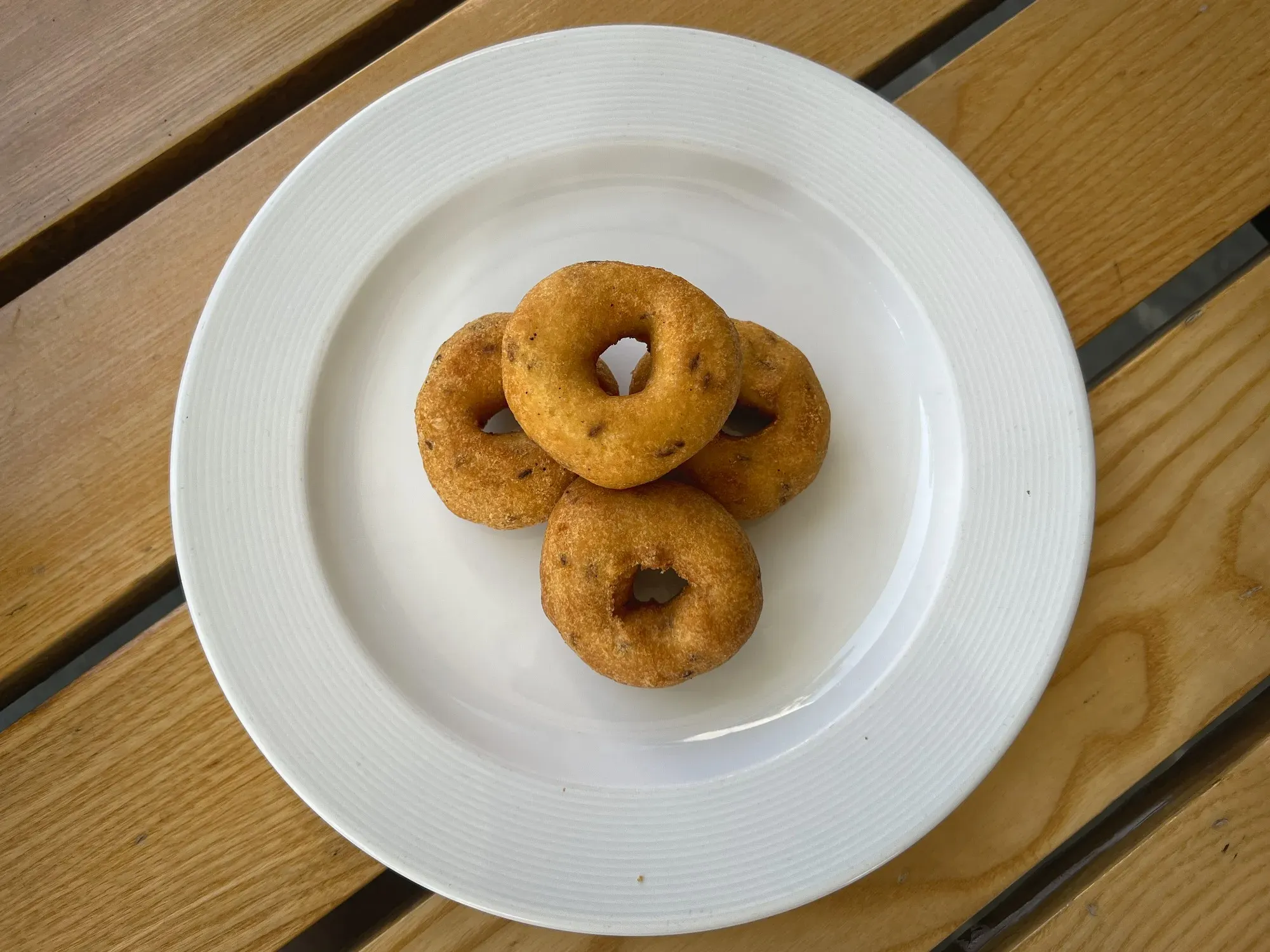
Vada is a popular South Indian food that is made by deep-frying a mixture of lentils or ground legumes, such as urad dal, moong dal, or chana dal. Originating in Southern India, vadas are an essential part of the South Indian cuisine, and are often eaten as a snack or breakfast item.
There are different types of vadas, each with its own unique preparation and taste. Medu vada is the most common variety, which is made from urad dal and is crispy on the outside, while soft and fluffy on the inside. Thayir vada is another popular variant, where vadas are soaked in yogurt and served with a spicy chutney. Masala vada, also known as parippu vada, is a savory version made with chana dal, spices, and onions.
In addition to the traditional South Indian varieties, there are also regional variations of vadas. For example, the bonda vada, originating from Maharashtra, is made by stuffing mashed potatoes inside a vada mixture and then deep-frying it. The Punugulu vada, hailing from Andhra Pradesh, are small-sized vadas made with a fermented batter of rice and urad dal.
Sambar / Rasam et. al
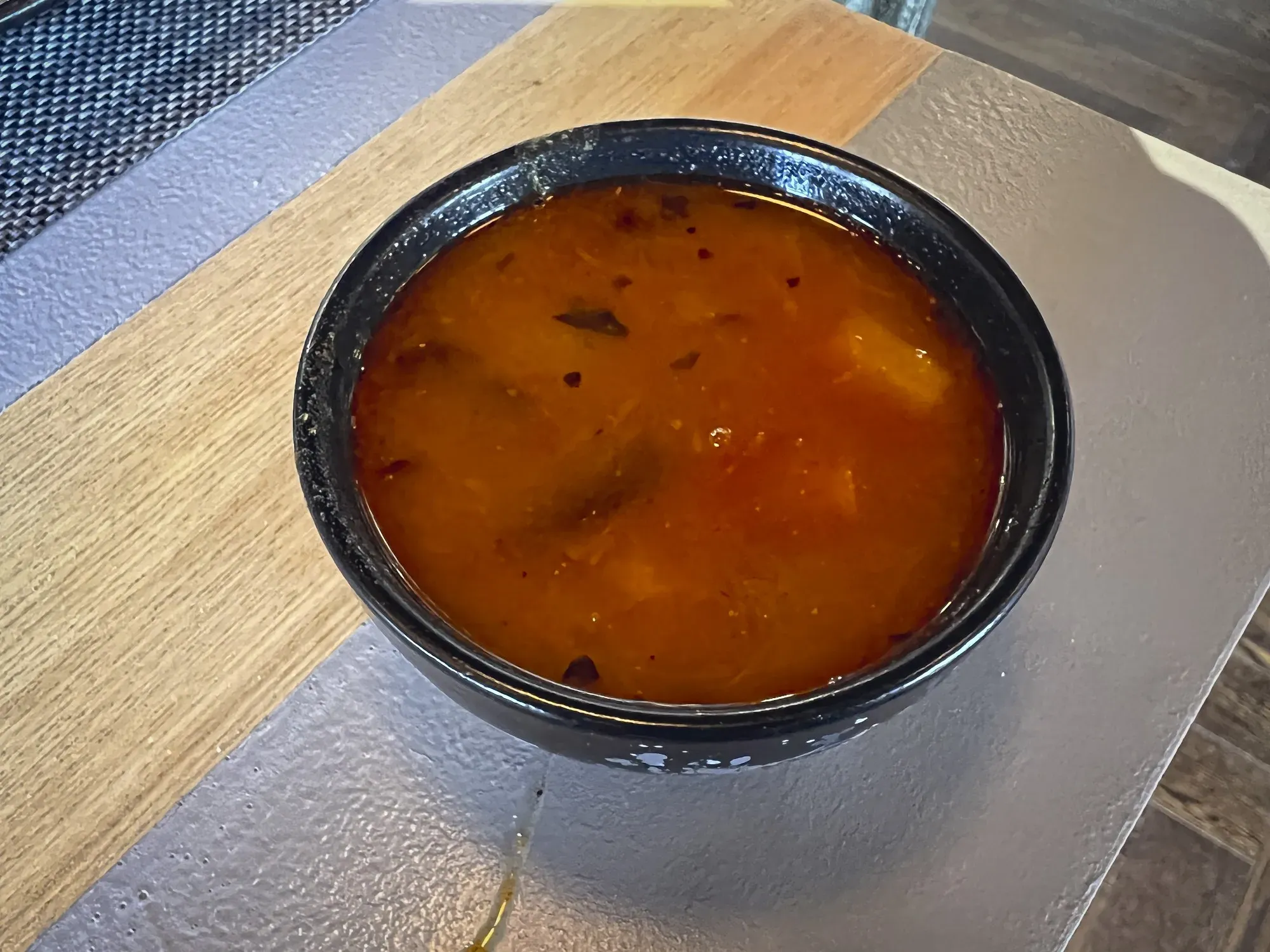
Sambar is a popular South Indian stew made with a variety of vegetables, lentils, tamarind, and a blend of aromatic spices. The dish is typically made by cooking a mix of lentils and vegetables, such as pumpkin, drumstick, brinjal, and okra, in a broth made of tamarind and spices. The lentil base provides the dish with protein, while the vegetables add a healthy dose of fiber, vitamins, and minerals. The final result is a rich, tangy, and slightly spicy stew that is typically served with steaming hot rice or idli. Sambar is a versatile dish that can be customized to suit different tastes and preferences; for example, a popular variation would be arachuvitta sambar (made with freshly ground spices).
Rasam is another South Indian dish that is akin to sambar, but with less or usually no lentils. Rasam ends up being a thinner tomato-based soup, spiced similarly to sambar (again, with room for some variety here based on the cook or region).
There are still more South Indian soups though! An important third type of soup to mention here and add to the wonderful family of South Indian soups would be tamarind-based soups. A popular example of this is Kuzhambu, popular in Tamil Nadu and Sri Lanka.
Uttapam
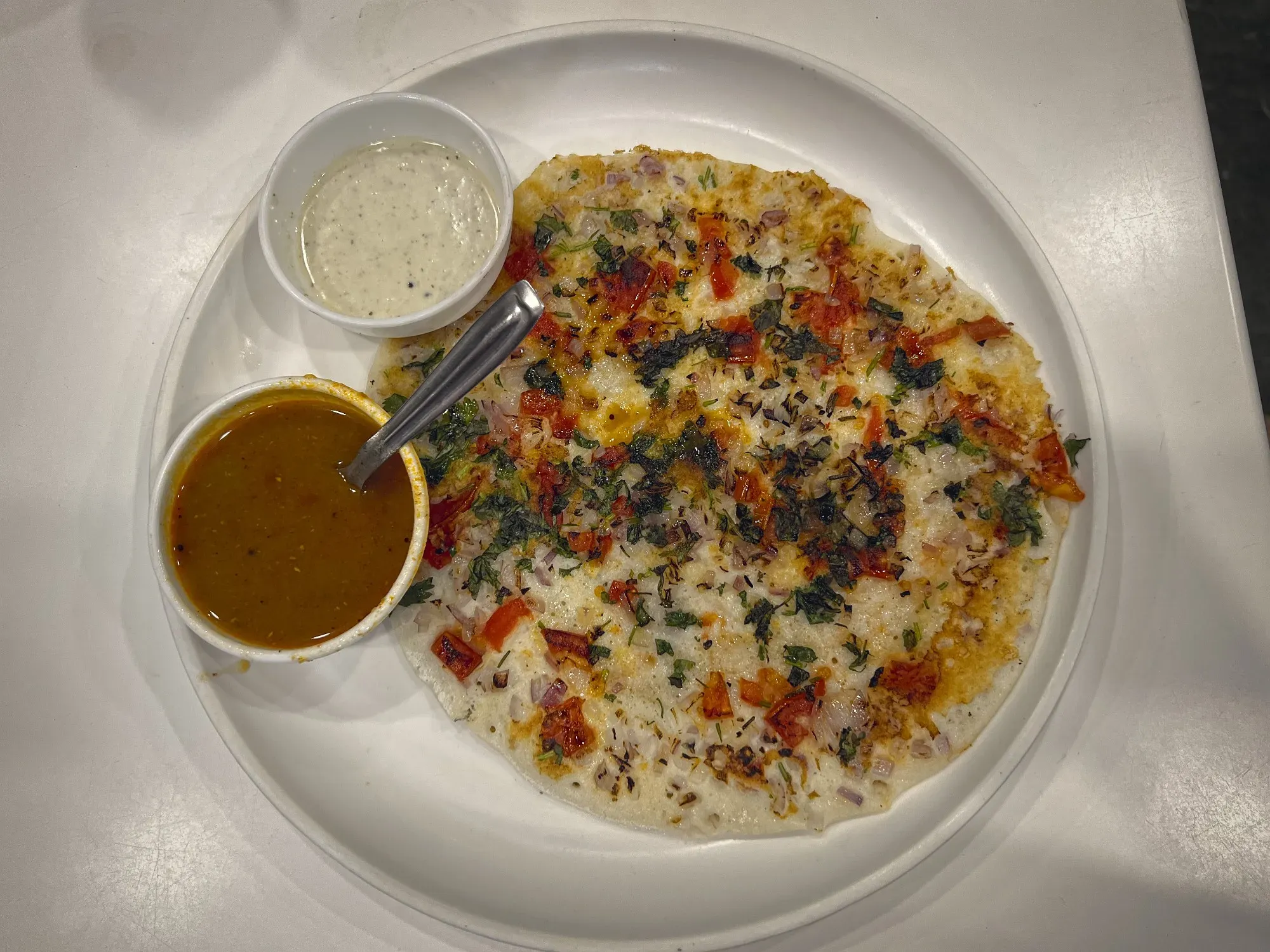
Uttapam is a popular South Indian dish that is a type of pancake made with fermented batter, similar to dosa. Originating in Tamil Nadu, Uttapam is typically made with a mixture of urad dal and rice batter, along with vegetables such as onions, tomatoes, and chilies. The batter is poured onto a hot griddle and allowed to cook until the edges are crisp and golden brown. Uttapam is usually served with coconut chutney, sambar, or tomato chutney.
Uttapam is a versatile dish that can be made with a variety of toppings, including cheese, paneer, and even fruits. It is often eaten for breakfast or as a snack and is popular throughout India and in other parts of the world. Uttapam is also known for its health benefits as it is a low-fat and low-calorie food, rich in protein and carbohydrates. It is a delicious and satisfying option for those who want to try something different from the traditional dosa.
Gobi Manchurian
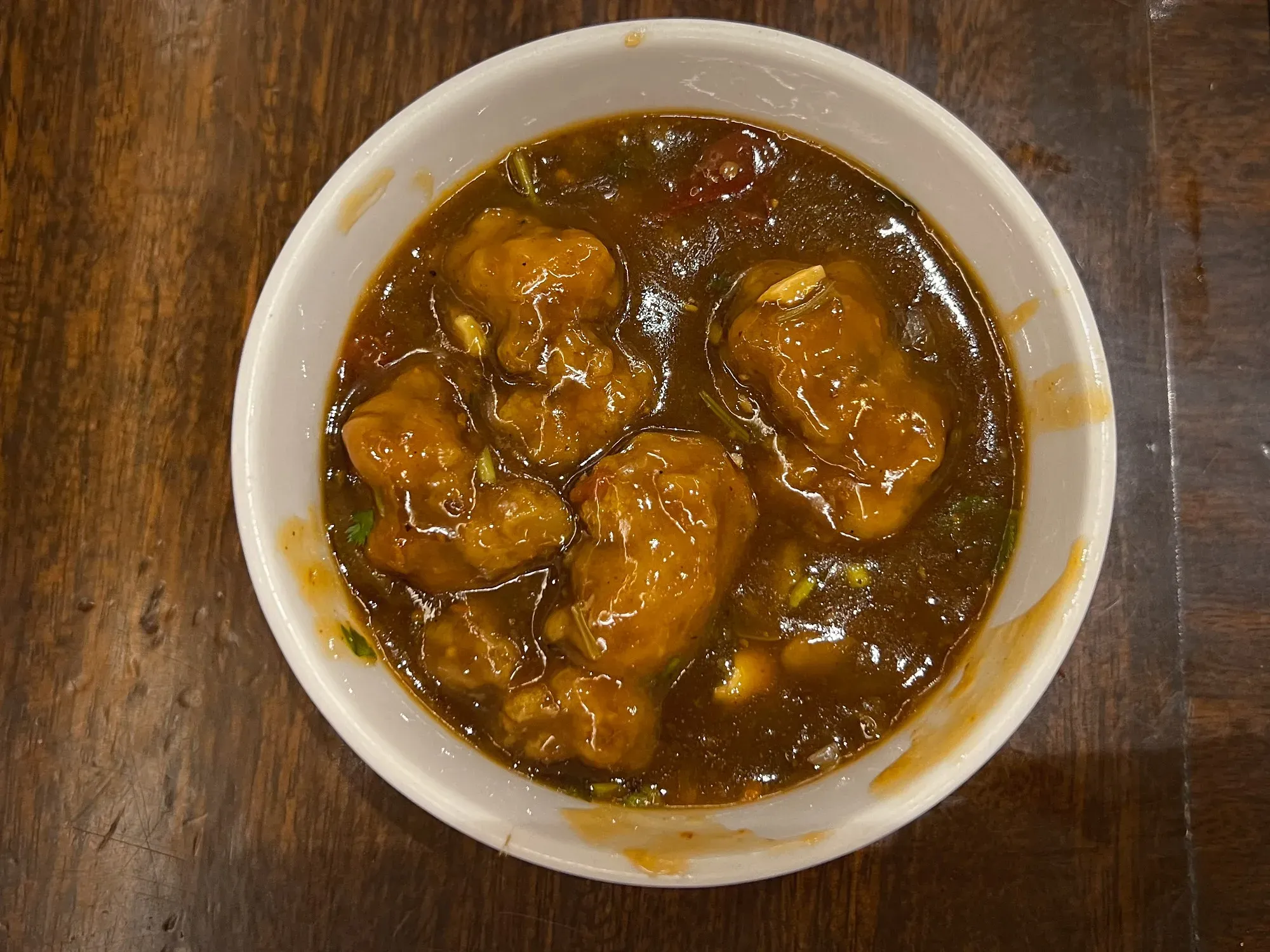
Gobi Manchurian is not a traditional Indian dish, but a fusion dish that originated in India. This popular Indo-Chinese dish is made with cauliflower florets, battered and fried, and then tossed in a flavorful sauce. It is believed to have originated in India among the Chinese community living in Kolkata in the 1960s. The dish gained popularity in other parts of India, even more so in Eastern India than Southern India at this point, and is now a common international restaurant dish.
The dish is prepared by first marinating the cauliflower florets in a batter made with flour, cornstarch, spices, and water, and then deep-frying until crispy. The sauce is made with a combination of soy sauce, garlic, ginger, green chilies, and other seasonings. The fried cauliflower is then tossed in the sauce until well coated, giving it a tangy and spicy flavor. It is often garnished with chopped spring onions and served as an appetizer or a side dish with rice or noodles.
Hyderabadi Biryani
Hyderabadi Biryani is probably most popular type of biryani, originating from Hyderabad in the Telangana region. Biryani was already covered in Northern India, but like many of the dishes in the international section of all four parts of Indian Gastronomy, biryani is pan-Indian and it just felt wrong to not give a quick call out to Hyderabadi Biryani when talking about South Indian dishes.
Regional-Specific Shoutouts
Appam
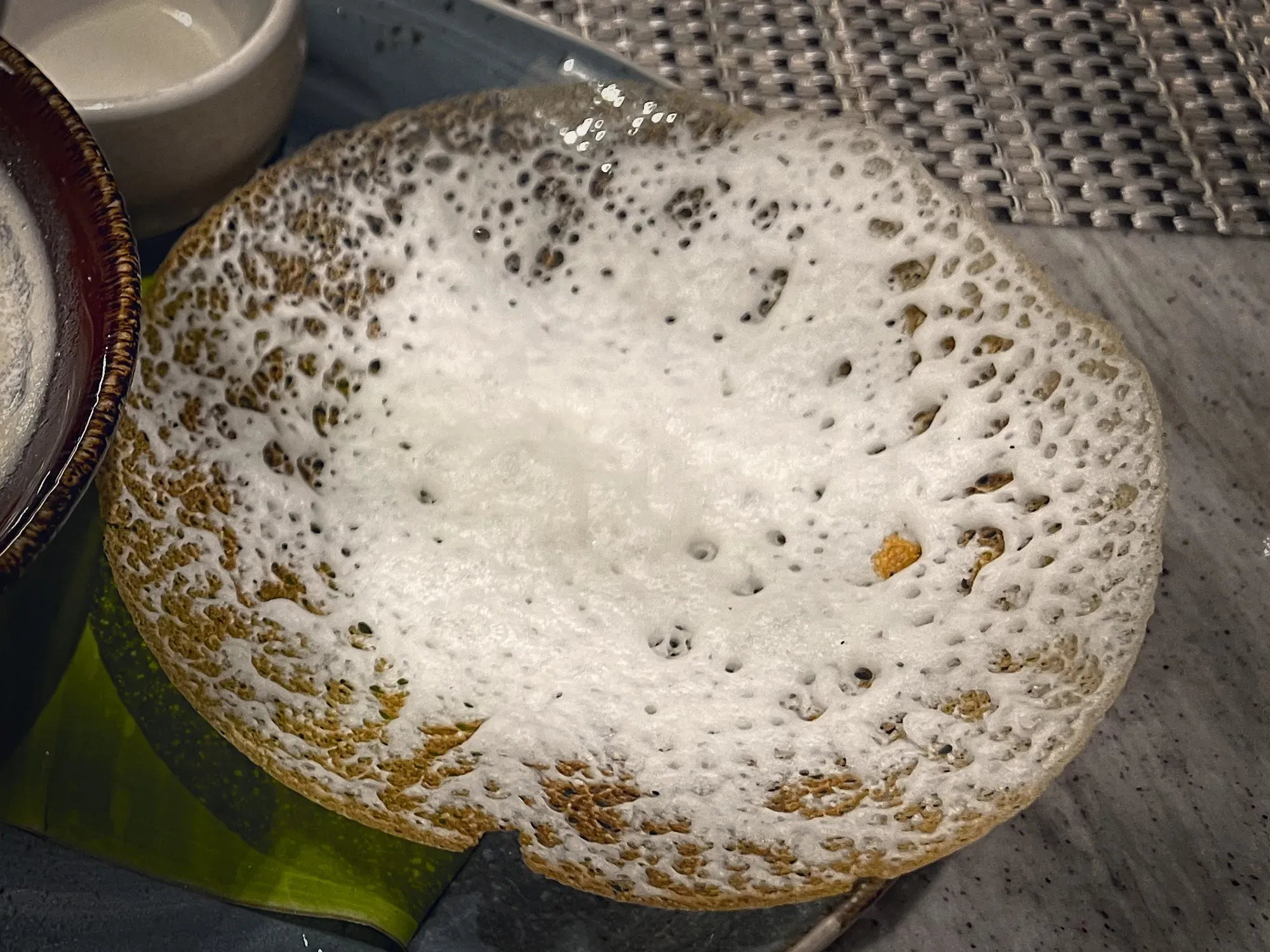
Appam is a soft, fluffy, and lacy rice pancake that is a popular breakfast dish in the southern Indian state of Kerala. It is made from a fermented batter of rice and coconut milk, which gives it a distinctive sweet taste and a slightly sour tang. The batter is poured onto a hot griddle and cooked until the edges turn crispy while the center remains soft and spongy.
The origin of appam is believed to be from Kerala, where it is often served with coconut milk-based stews or curries, such as vegetable stew or chicken curry. Appam is also a popular dish in the neighboring state of Tamil Nadu, where it is known as "appa" or "hopper." It is also a popular breakfast item in Sri Lanka and certain parts of Southeast Asia.
Upma
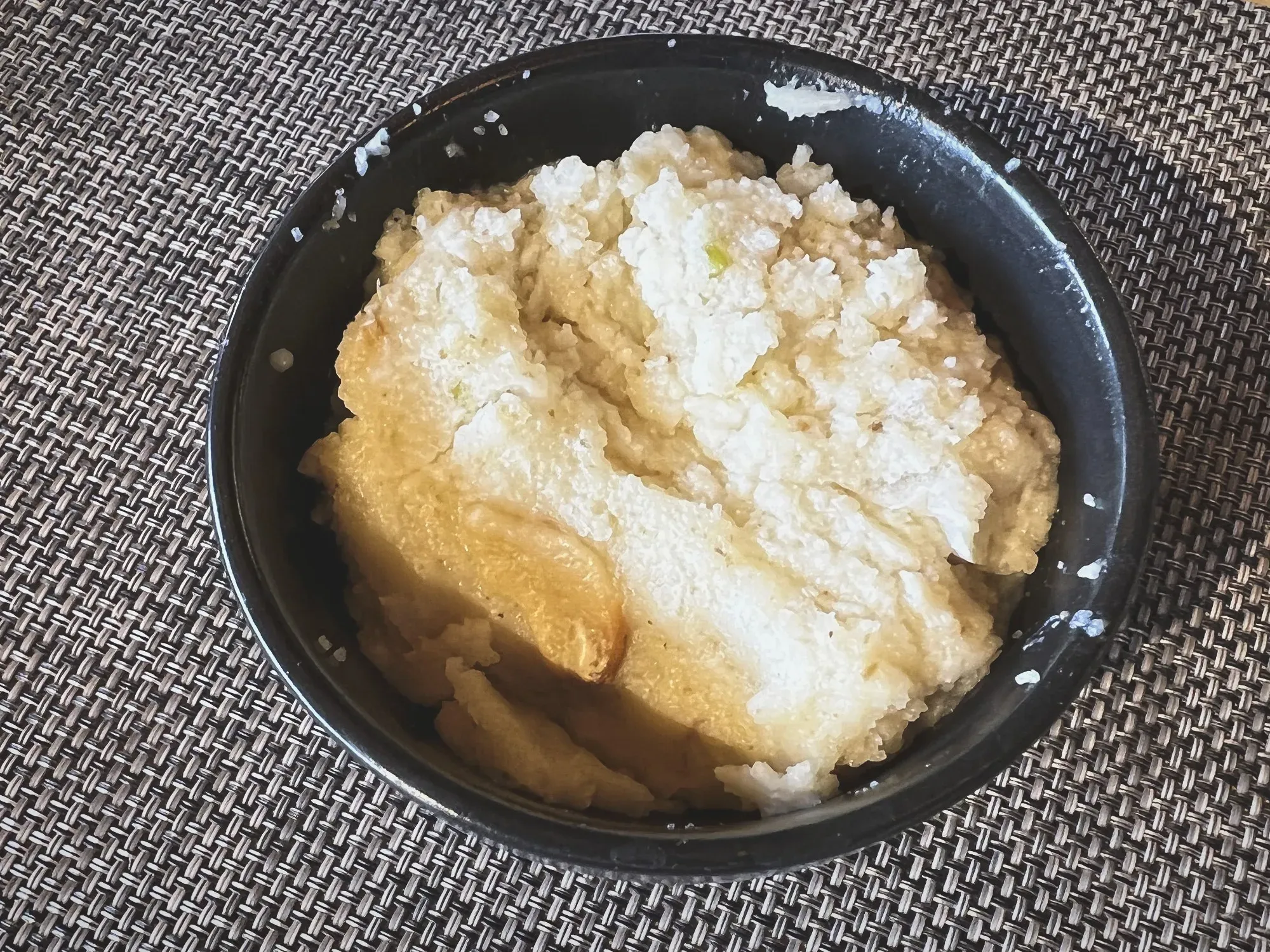
Upma is a traditional South Indian breakfast dish that is popular across India. It is a savory porridge made from dry-roasted semolina (a type of wheat flour), along with onions, green chilies, and other vegetables such as peas, carrots, and tomatoes. The dish is seasoned with curry leaves, mustard seeds, and turmeric powder, giving it a distinct flavor and aroma.
Upma is believed to have originated in South India, where it has been a staple breakfast dish for generations. It is a quick and easy dish to make and can be enjoyed on its own or with chutney, pickle, or sambar. In recent years, different variations of upma have become popular, including tomato upma, onion upma, and vegetable upma, each with their own unique flavor and texture. Upma is a versatile and nutritious dish that is perfect for a quick and satisfying breakfast or snack.
Pongal
Pongal is a popular South Indian breakfast dish that is made with rice and lentils. While similar to an Upma, it is distinctly different. The dish is named after the Tamil harvest festival of Pongal, which is celebrated in January.
Traditionally, Pongal is made in a clay pot over a firewood stove, which gives it a unique smoky flavor. The ingredients are simple, but the dish is packed with flavor from the use of cumin, black pepper, ginger, and curry leaves. The rice and lentils are cooked together until they are soft and creamy, resulting in a porridge-like consistency.
Ishtu
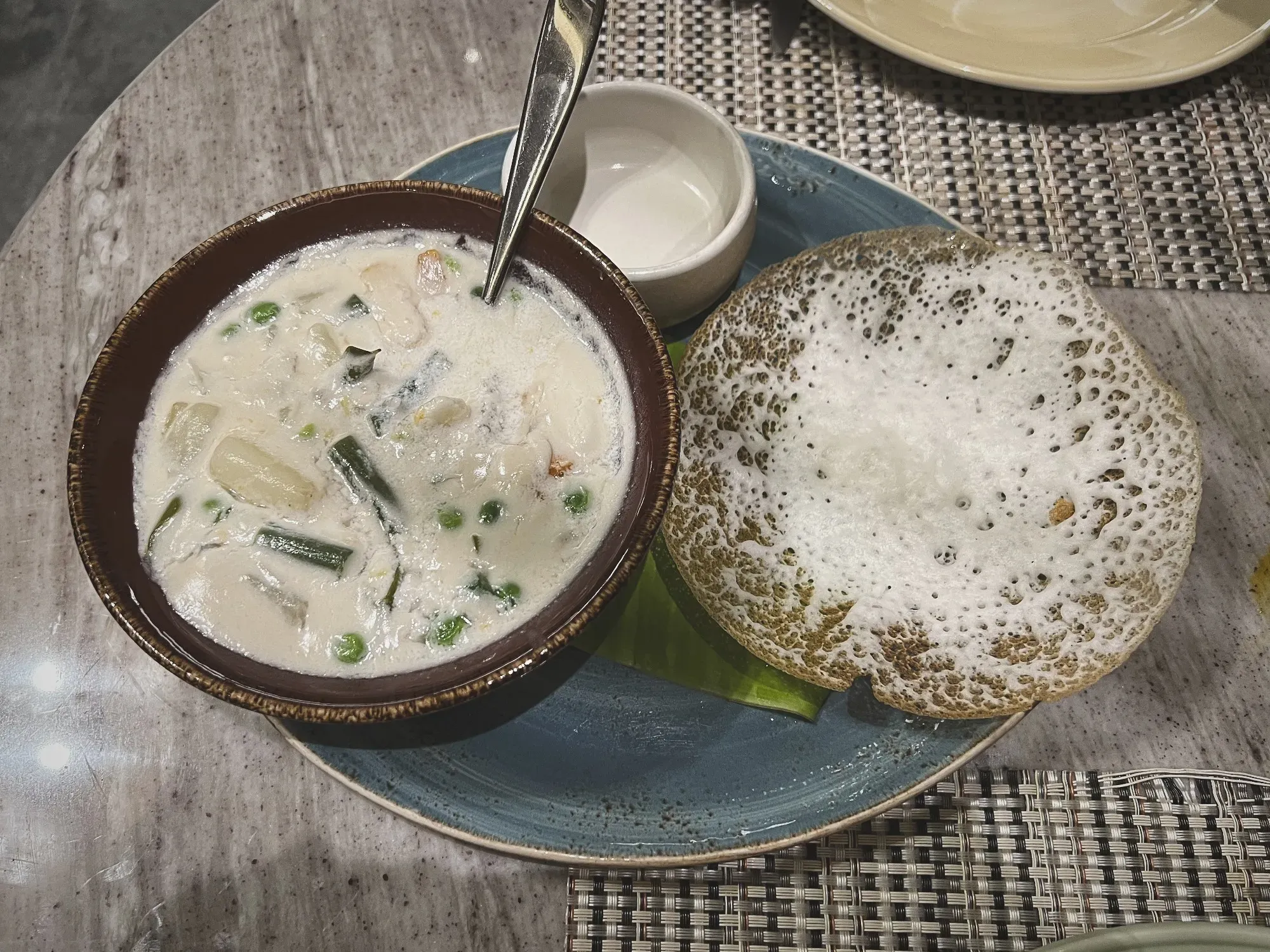
Ishtu is a mild and creamy South Indian stew that is typically made with potatoes and coconut milk. It is believed to have originated in Kerala, a state in southern India. The dish is often served as a breakfast or brunch item, and is typically paired with appam or bread.
To make ishtu, potatoes are boiled and simmered in a coconut milk-based broth that is flavored with onions, ginger, green chilies, and spices like cinnamon, cardamom, and cloves. The result is a flavorful and aromatic stew that has a creamy texture and a hint of sweetness from the coconut milk.
Ishtu can also be made with other vegetables like carrots or green beans, and can be customized to suit different tastes and preferences. It is a comforting and satisfying dish that is enjoyed by many in southern India.
Puttu
Puttu, also known as Pitu, is a popular South Indian and Sri Lankan breakfast dish made from steamed rice flour and coconut. It is a cylindrical-shaped dish that is cooked in a special vessel called a "Puttu Kutti," which is a tall, narrow metal or bamboo tube. The rice flour is mixed with grated coconut and water, and then layered with more grated coconut before being steamed.
Puttu is believed to have originated in the Indian state of Kerala, where it is a staple breakfast dish. It is often served with sweet bananas, papadum, or chickpea curry (see Kadala below). Puttu is also popular in the neighboring state of Tamil Nadu, where it is usually served with grated coconut, jaggery, or curry.
There are several variations of puttu, including using ragi flour (finger millet) or wheat flour instead of rice flour. It is a nutritious and filling breakfast dish that is popular not just in South India and Sri Lanka, but also in Southeast Asian countries such as Malaysia and Singapore, where it is known as "Kuetiau."
Kadala
Kadala curry is a spicy and tangy curry made with black chickpeas cooked in a blend of spices and coconut milk. It is often served with puttu.
Chicken 65
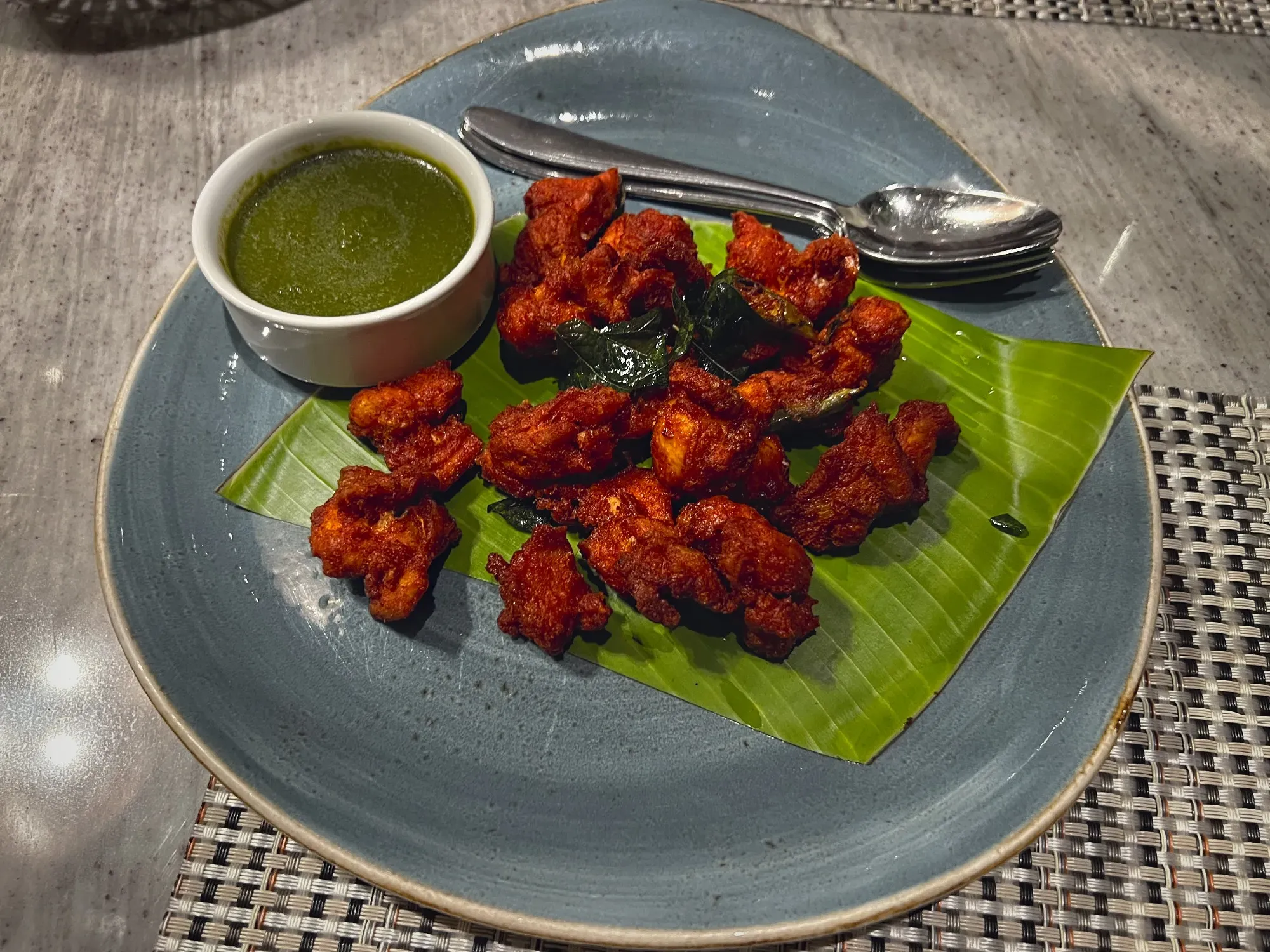
Chicken 65 is a popular Indian snack that consists of small pieces of boneless chicken marinated in a blend of spices and then deep-fried. The dish is said to have originated in Chennai, Tamil Nadu, in the 1960s, at the famous Buhari Hotel. The dish was first introduced as "Chicken 65" on the menu because it was the 65th dish to be added to the menu.
The exact recipe for Chicken 65 can vary depending on the region, with some variations using yogurt or vinegar in the marinade, and others adding ingredients like curry leaves and mustard seeds. Some versions also include a garnish of fried curry leaves and green chilies. Chicken 65 is typically served as an appetizer or snack, and is known for its spicy and tangy flavor.
Chicken Chettinad
Chicken Chettinad is a popular dish from the Chettinad region of Tamil Nadu, India. It is a spicy and flavorful dish that is made with a unique blend of spices and herbs. The dish is made by marinating chicken pieces in a mix of spices, including cumin, fennel, cinnamon, cloves, and cardamom, along with ginger, garlic, and onions. The chicken is then cooked in a rich and tangy sauce that includes tomatoes, tamarind, and coconut milk. The dish is typically served with rice or flatbreads like naan or roti.
Chicken Chettinad is believed to have originated from the Chettiar community, a merchant caste from Tamil Nadu who were known for their cuisine. The dish has gained popularity not just in Tamil Nadu but all over India and around the world due to its unique and delicious flavors.
Bisi bele bath
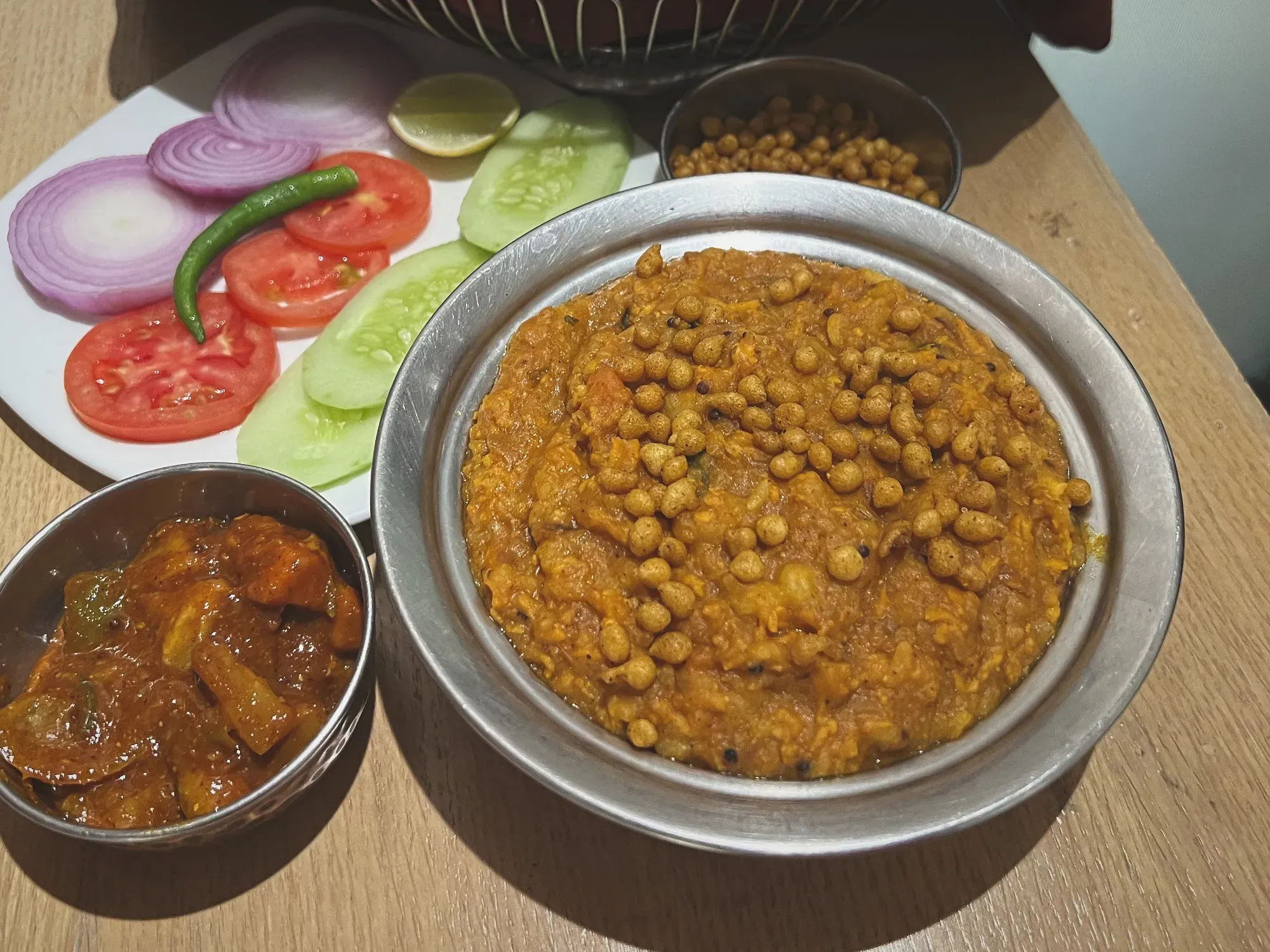
Bisi bele bath is a popular rice-based dish originating from the state of Karnataka in South India. The name 'bisi bele bath' means 'hot lentil rice' in the Kannada language, referring to the dish's hot and spicy flavor. The dish is made with a mix of rice, lentils, and vegetables cooked with a special blend of spices, including curry leaves, cinnamon, cloves, and tamarind pulp. The use of these spices gives the dish a distinct flavor and aroma. Bisi bele bath is often served with a side of raita, a yogurt-based side dish that helps to balance out the spiciness of the main dish. Bisi bele bath is a traditional dish that is commonly served during festivals and special occasions in Karnataka.
Pulihora
Pulihora is a popular South Indian dish made from cooked rice mixed with a souring agent, spices, and peanuts. The tangy flavor of the souring agent combined with the crunch of peanuts and the heat of the spices make it a flavorful and satisfying dish. Tamarind is the most common souring agent, but kokum, lemon, or green mango are popular options as well (usually the name pulihora morphs into a localized name depending on the souring agent). Pulihora is believed to have originated in the state of Andhra Pradesh in South India and has since spread to other parts of the region. Pulihora is often prepared in large batches and can be served hot or cold. It is also a popular dish for travel and is known for its long shelf life.
Curd Rice
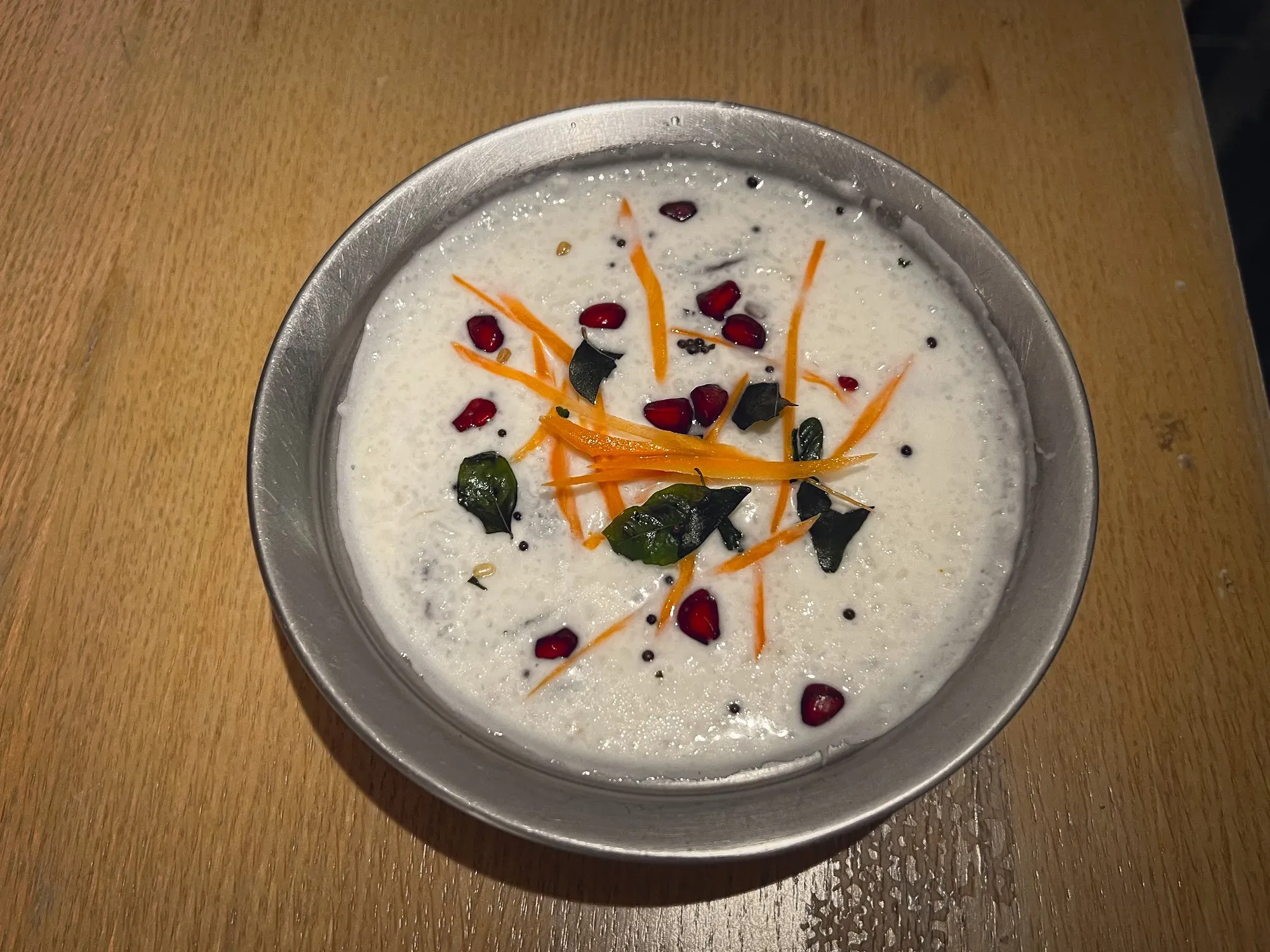
Curd rice is a popular rice style in South India. It is made by mixing cooked rice with yogurt and seasoned with spices such as cumin, mustard seeds, curry leaves, ginger, and chopped green chilies. Curd rice is believed to have originated in the South Indian state of Tamil Nadu and has been a part of the traditional Tamil cuisine for centuries. It is also a popular dish in the neighboring states of Karnataka, Andhra Pradesh, and Telangana. Curd rice is considered a comfort food and is often served as a cooling dish during hot summers or after a spicy meal.
Fish Moole
Fish Moole is a traditional seafood dish from the coastal state of Kerala in India. The word "moole" comes from the Malayalam language, which means "stew." It is a curry made with fish, coconut milk, and a blend of spices, including turmeric, cumin, coriander, and black pepper. The dish is typically prepared with boneless fish fillets, and the gravy is thick and creamy with a tangy flavor. It is usually served with steamed rice or appam, a type of fermented rice pancake.
Fish Moole is believed to have originated in the Malabar region of Kerala, which has a long coastline along the Arabian Sea. The region's cuisine is known for its bold flavors, influenced by Arab, Portuguese, and Dutch traders who traveled through the area for centuries. Fish Moole is a popular dish among the local communities, especially during special occasions such as weddings and festivals. Its rich flavors and creamy texture make it a favorite among seafood lovers, not just in Kerala but also around the world.
Kerala Prawn Curry (Konju Varutharaccha Curry)
Konju Varutharaccha Curry is a popular seafood dish from the southern Indian state of Kerala. It is a delicious prawn curry that is cooked in a spicy coconut-based gravy. The name "Konju Varutharaccha" roughly translates to "prawns roasted and cooked in a gravy."
To make the dish, prawns are first marinated in a blend of spices such as red chili powder, turmeric, coriander powder, and black pepper. They are then roasted and added to a curry made with coconut milk, onions, tomatoes, and a variety of spices. The curry is usually finished off with a tempering of curry leaves and mustard seeds. Konju Varutharaccha Curry is often served with steamed rice or appam, a type of rice pancake.
Kootu
Kootu is a South Indian vegetarian dish that consists of vegetables cooked with lentils and spices. The cooking style of the lentils results in a curry with the consistency of many North Indian curries. It is a nutritious and flavorful dish that can be served as a side dish or as a main course with rice or Indian bread. The dish is believed to have originated in Tamil Nadu, India.
Kootu is made by boiling vegetables with lentils and spices until they are tender and flavorful. The lentils used can vary, but commonly used are toor dal or chana dal. The dish is seasoned with a blend of South Indian spices, including mustard seeds, cumin seeds, curry leaves, and red chilies. Kootu can be made with a variety of vegetables, including beans, pumpkin, cabbage, and spinach. Some versions of the dish also include coconut, which adds a creamy texture and a subtle sweetness to the dish. It is typically served hot and garnished with fresh coriander leaves.
Coorg Curry
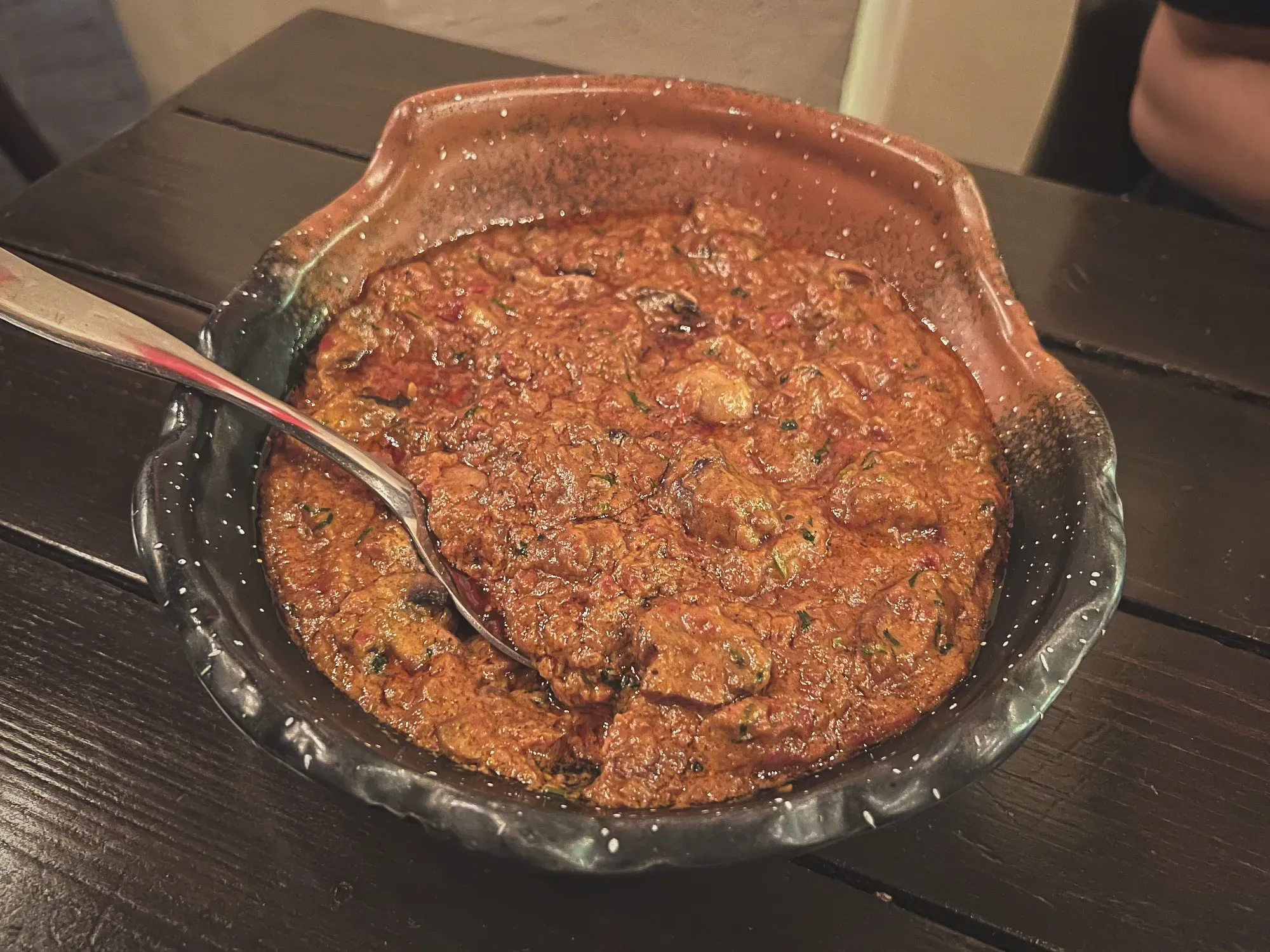
Coorg curry, a part of the Kodava cuisine, is a regional delicacy from the Kodagu district in the state of Karnataka, India. The cuisine of this region is unique and heavily influenced by the local culture and traditions. Coorg curry is made using a variety of meats such as pork, chicken, and mutton, and is characterized by its rich and aromatic flavors. The curry is prepared using a blend of traditional spices such as cinnamon, cloves, cardamom, and star anise. It is also enriched with coconut milk, giving it a creamy and smooth texture. Coorg curry is typically served with rice, akki roti (rice flour flatbread), or bread. It is a popular dish in restaurants and homes in the region and has gained popularity across India as well.
Avial
Avial is a traditional vegetarian dish that originated in the southern Indian state of Kerala. It is a mixed vegetable curry that is made with a variety of vegetables such as pumpkin, yam, carrot, drumstick, beans, and eggplant, cooked in a coconut-based sauce with curry leaves, green chilies, and yogurt. The dish has a creamy texture and a mild flavor, making it a perfect side dish to accompany rice, roti or dosa. Avial is often served on special occasions and festivals in Kerala, such as Onam. It is also popular in other south Indian states, such as Tamil Nadu and Karnataka, and is often served in traditional south Indian thalis or meals.
List of Other Things to Try:
- Kerala Karimeen Fry: A popular Kerala fish fry made with pearl spot fish marinated in spices and fried in coconut oil. Origin: Kerala
- Thotakura: A South Indian stew made with amaranth leaves and pigeon peas. Origin: Andhra Pradesh
- Pappu: A South Indian dal dish made with pigeon peas or lentils that have been tempered with spices and garnished with herbs. Origin: Andhra Pradesh and Telangana
- Pulihora / Pulihaara: A tangy and spicy South Indian rice dish made with tamarind or lemon juice and tempered with spices. Origin: Andhra Pradesh and Telangana
- Dosakaya: A South Indian stew made with yellow cucumber and pigeon peas. Origin: Andhra Pradesh and Telangana
- Sakinalu: A popular South Indian snack made with rice flour and spices, shaped into a spiral and deep-fried. Origin: Telangana and Andhra Pradesh
- Rawa Laddu: A popular South Indian sweet made with semolina, ghee, sugar, and nuts. Origin: Tamil Nadu
- Mysore Pak: A rich and buttery South Indian dessert made with gram flour, sugar, and ghee. Origin: Karnataka
- Vidi Bele Bhaat: A traditional South Indian rice dish made with urad dal and rice, flavored with spices and herbs. Origin: Karnataka
- Mutton Kola Urundai: A South Indian appetizer made with minced mutton and spices, shaped into balls and deep-fried. Origin: Tamil Nadu
- Ayala Curry: A spicy South Indian fish curry made with mackerel, tamarind, and coconut milk. Origin: Kerala
- Prawn Kuzhambu: A spicy South Indian prawn curry made with tamarind and coconut milk. Origin: Tamil Nadu
- Nawaabi Kebabs: A South Indian appetizer made with minced meat, spices, and herbs, grilled over charcoal. Origin: Andhra Pradesh and Telangana
- Egg Pulusu: A South Indian egg curry made with tamarind, tomatoes, and spices. Origin: Andhra Pradesh and Telangana
- Nalli Massam: A South Indian lamb curry made with bone marrow, onions, and spices. Origin: Andhra Pradesh and Telangana
- Gonguru Mamsam: A South Indian lamb curry made with sorrel leaves, onions, and spices. Origin: Andhra Pradesh and Telangana
- Patrode: A South Indian steamed dumpling made with colocasia leaves and lentil filling. Origin: Karnataka
- Andhra Curry: A spicy South Indian curry made with chicken or lamb, flavored with tamarind and red chili powder. Origin: Andhra Pradesh.
- Karimeen pollichathu: A popular fish dish from Kerala, made by marinating fish in spices and wrapping it in banana leaves before grilling or baking.
- Mutton sukka: A spicy and dry mutton dish from Karnataka, made with a blend of spices like red chili, coriander, and cumin.
- Bheja Tawa Fry: Goat brain fry from Hyderabad.
- Keerai Masiyal: A spinach-based dish, often mixed with lentils and seasoned with garlic and chili.
Resources
Restaurant Recommendations
India is so large and populated, with incredible hole-in-the-wall restaurants around every corner. Food culture is so strong in this country, and any random local restaurant has the possibility to blow your mind with the chefs personal spice blend or dosa recipe. For Southern India, I will advocate for the local's favorite- Mavalli Tiffin Rooms. Mavalli Tiffin Rooms, colloquially called MTR, is a canteen-esque restaurant with great South Indian options that locals swear by. Great deal, great food, you can not go wrong with lunch here.
To see an extensive list of restaurant recommendations in India, check out the Restaurants page to see a map of our top recommendations for Asia as well as the database with details on restaurants from all around the world.





